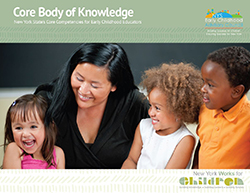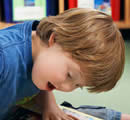


Area 4: Environment and Curriculum
The essence of the work of an early childhood education lies in the learning experiences provided for the children under his or her care. The higher the quality of these experiences, the better the outcomes for the children. Ensuring quality learning experiences involves careful planning, implementation, and evaluation not only of the content of such experiences but also of the physical and social settings that surround them.
Environment and curriculum are interdependent parts of a continuum of care and education in early childhood settings: Decisions made in regards to one impact the other. Their foundations lie on the knowledge of children's growth and development as well as on a critical understanding of social responsibility. Combined, these elements make up what is known as developmentally appropriate and emotionally responsive practice.
In thinking of environment and curriculum, an early care education must consider several aspects. First of all, both environment and curriculum must be designed for the children. Secondly, learning takes place everywhere, so in preparing the environment and planning curriculum professionals must include in their thinking all areas in the early childhood setting - indoors and outdoors. Thirdly, time plays a substantial role in learning and development, and professionals who work with young children must always keep in mind that allowing and encouraging children to repeat, revisit, and reflect on earlier experiences leads to deeper understandings and consequently richer learning. A pace that respects each child's development and diverse abilities also constitutes appropriate practice. Lastly, aesthetically pleasing and well-designed surroundings facilitate children's relationships with people and materials, therefore laying the foundations for exploration, interaction, and meaningful connections.
Core Competencies:
Select a competency below to view the competency profile, including the associated behaviors and skills.
The professional working with young children:
-
4.1
Creates genuine, supportive relationships with children
-
4.2
Creates an environment that is predictable, promotes interaction and learning, and is responsive to children's needs
-
4.3
Works to effectively and calmly address challenging behavior
-
4.4
Creates an environment that values the inclusion of all children
-
4.5
Fosters a sense of community by encouraging interaction, empathy, connectedness, responsibility, and independence
-
4.6
Arranges a learning environment that is well organized, aesthetically pleasing, promotes reflection, and extends learning
-
4.7
Arranges and facilitates the use of the physical space and materials in ways that support healthy development, self-management, and cooperation
-
4.8
Uses approaches to learning that build on children's natural curiosity, deepen children's knowledge and awareness, and sustain active engagement with ideas and materials
-
4.9
Adopts or designs meaningful curriculum for young children
-
4.10
Makes sound decisions for selecting and using technology and media to enhance teaching and learning
-
4.11
Plans and implements interventions to help children meet developmental and learning goals
